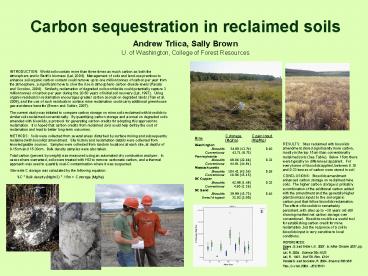Carbon sequestration in reclaimed soils - PowerPoint PPT Presentation
1 / 1
Title:
Carbon sequestration in reclaimed soils
Description:
Carbon sequestration in reclaimed soils Andrew Trlica, Sally Brown U. of Washington, College of Forest Resources INTRODUCTION: World soils contain more than three ... – PowerPoint PPT presentation
Number of Views:53
Avg rating:3.0/5.0
Title: Carbon sequestration in reclaimed soils
1
Carbon sequestration in reclaimed soils
Andrew Trlica, Sally Brown
U. of Washington, College of Forest Resources
INTRODUCTION World soils contain more than
three times as much carbon as both the atmosphere
and in Earths biomass (Lal, 2004). Management
of soils and land-use practices to enhance soil
organic carbon content could remove up to one
million tonnes of carbon per year from the
atmosphere, a significant move to slow the rise
in atmospheric carbon dioxide levels (Pacala and
Socolow, 2004). Similarly, reclamation of
degraded soils worldwide could potentially
capture 3 million tonnes of carbon per year
during the 20-50 years of initial soil recovery
(Lal, 1997). Using organic residuals in
reclamation encourages greater carbon accrual on
degraded lands (Tian et al. 2009), and the use of
such residuals in surface mine reclamation could
carry additional greenhouse gas avoidance
benefits (Brown and Subler, 2007). The current
study was initiated to compare carbon storage on
mine soils reclaimed with biosolids to similar
soils reclaimed conventionally. By quantifying
carbon storage and accrual on degraded soils
amended with biosolids, a protocol for generating
carbon credits for adopting this approach to
reclamation. It is hoped that carbon credits
from reclaimed soils could help defray the cost
of reclamation and lead to better long-term
outcomes. METHODS Soils were collected from
several areas disturbed by surface mining and
subsequently reclaimed with biosolids amendment.
Site history and reclamation details were
collected from knowledgeable sources. Samples
were collected from random locations at each
site, at depths of 0-15cm and 15-30cm. Bulk
density samples were also taken. Total carbon
(percent by weight) was measured using an
automated dry combustion analyzer. In cases
where warranted, soils were treated with HCl to
remove carbonate carbon, and a thermal approach
was used to quantify coal-C contamination where
it was suspected. Site-wide C storage was
calculated by the following equation C
Bulk density (Mg/m3) .15m C storage (Mg/ha)
RESULTS Sites reclaimed with biosolids
amendment stored significantly more carbon,
mostly in the top 15cm than conventionally
reclaimed soils (See Table). Below 15cm there
were typically no differences apparent. For
every tonne of biosolids applied, between 0.10
and 0.33 tonnes of carbon were stored in soil
CONCLUSIONS Biosolids amendment enhanced carbon
storage on reclaimed mine soils. The higher
carbon storage is probably a combination of the
additional carbon added with the amendment and
the generally higher plant biomass inputs to the
soil organic carbon pool that follow biosolids
reclamation. The effect of biosolids is
remarkably persistent, with sites up to 30 years
old still showing marked net carbon storage over
conventional. Biosolids could be a useful tool
for establishing carbon credit for mine
reclamation, but the response of a soil to
biosolids input is very sensitive to local
conditions.
REFERENCES Brown, S. and Subler, S. 2007. In
Mine Closure 2007, pp. 459. Lal, R. 2004.
Science 3041623 Lal, R. 1997. Soil Till. Res.
4391 Pacala S. and Socolow, R. 2004. Science
305968 Tian, G et al. 2009. JEQ 3861

